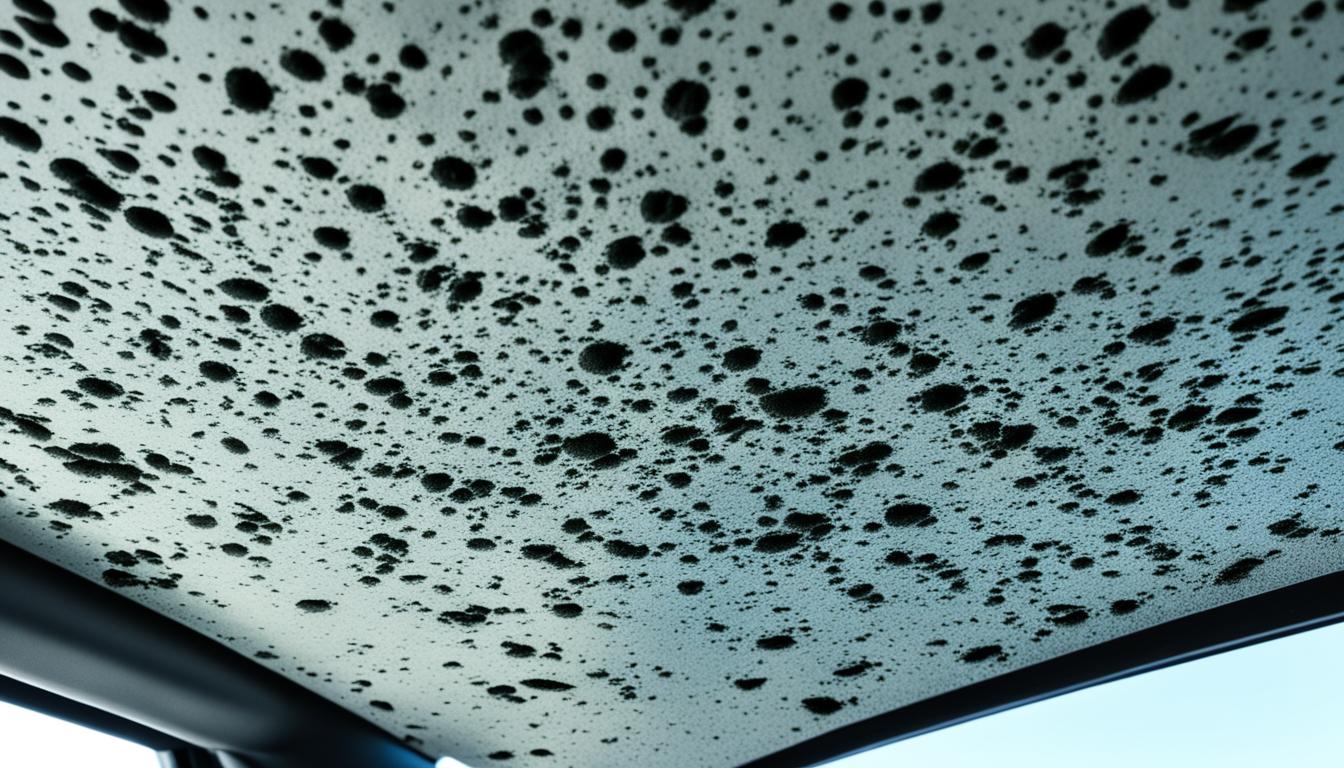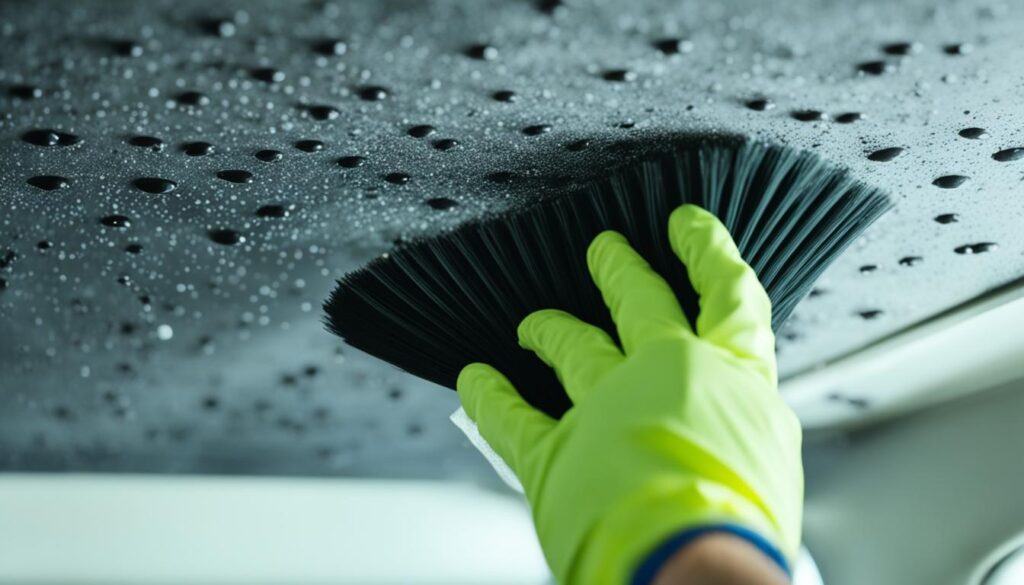
Car Headliner Mold Removal & Prevention Guide
Welcome to our comprehensive guide on car headliner mold removal and prevention. If you’ve ever experienced mold growth on your car’s headliner, you know how frustrating and unpleasant it can be. In this article, we will provide you with practical tips and techniques to effectively remove mold from your car’s headliner and prevent it from coming back.
Key Takeaways:
- Mold growth on car headliners is a common issue that can be effectively addressed.
- Understanding the causes of mold, such as moisture buildup and poor ventilation, is essential for prevention.
- Proper cleaning and disinfecting techniques can help remove visible mold and prevent future growth.
- Maintaining good ventilation and addressing any moisture issues are crucial for a mold-free car interior.
- If you require professional assistance, contact Fix Mold Miami at 305-465-6653.
Now, let’s dive into the possible causes of mold on car headliners.
Understanding the Causes of Mold on Car Headliners
Before diving into the automotive mold cleaning and prevention methods, it’s crucial to gain a comprehensive understanding of the root causes of mold growth on car headliners. By addressing these underlying factors, you can effectively remove mold from your car’s ceiling while taking preventive measures to ensure it doesn’t return.
One of the main drivers of mold development on car headliners is moisture buildup. Water can seep into the interior of your car through various sources, such as leaks, spills, or wet clothing. When moisture remains trapped in the headliner, it creates an ideal environment for mold to thrive.
Poor ventilation is another contributing factor. Without sufficient airflow, moisture-laden air becomes stagnant, further promoting mold growth. This is especially common in cars that are frequently parked in humid environments or those equipped with defective ventilation systems.
Contaminated air circulation can also lead to mold on car headliners. If your car’s air conditioning system is contaminated with mold spores or other allergens, it can spread these particles to the headliner, creating an environment conducive to mold growth.
To effectively remove mold from your car’s ceiling, it’s important to identify its presence. Look for visible signs of mold, such as dark spots or discoloration on the headliner. Additionally, be mindful of any musty odors, which can be a telltale sign of mold growth.
Once you’ve identified the mold, several methods can help you remove it. These include:
- Vacuuming: Use a vacuum cleaner with a HEPA filter to remove loose mold spores from the headliner surface.
- Cleaning solutions: Apply commercial mold removal solutions or a homemade mixture of vinegar and water to gently clean the affected area. Use a soft brush or sponge to scrub the surface and remove the mold.
- Steam cleaning: If the mold growth is extensive, consider using a steam cleaner to eliminate the mold effectively.
Quote:
Mold growth on car headliners can be a persistent issue, but by understanding the causes and implementing the right cleaning methods, you can restore a mold-free environment to your car’s interior.

| Mold Removal Method | Mold Removal Effectiveness |
|---|---|
| Vacuuming | Good for removing loose mold spores on the surface |
| Cleaning solutions | Effective for gently cleaning the headliner and removing mold |
| Steam cleaning | Ideal for extensive mold growth and deep cleaning |
Cleaning and Preventing Mold on Car Headliners
When it comes to keeping your car interior clean and free from mold, prevention is key. However, if you have already spotted mold on your car headliner, it’s essential to take immediate action to prevent further damage. In this section, we will guide you through the step-by-step process of cleaning and preventing mold on car headliners, ensuring a healthy and mold-free environment inside your vehicle.
Removing Visible Mold
The first step in tackling mold on your car headliner is to carefully remove any visible mold growth. Start by using a soft brush or cloth to gently wipe away the mold from the affected areas. Be cautious not to scrub too vigorously, as this may damage the headliner material. Once you have removed the visible mold, dispose of the brush or cloth to avoid spreading spores to other areas.
For stubborn mold spots, you can create a homemade cleaning solution by mixing equal parts water and white vinegar. Dampen a clean cloth with the solution, then gently blot the mold-infested area. Avoid saturating the headliner to prevent water damage. After blotting, allow the headliner to air dry completely.
Disinfecting the Affected Area
To ensure that all mold spores are eliminated, it’s crucial to disinfect the affected area thoroughly. Prepare a mixture of one part water and one part hydrogen peroxide in a spray bottle. Lightly mist the headliner, focusing on the areas previously affected by mold.
Allow the hydrogen peroxide solution to sit on the headliner for about 10 minutes to effectively kill any remaining mold spores. After waiting, use a clean cloth to gently blot the headliner and remove the solution. Again, air dry the headliner completely before moving on to the next step.
Preventing Future Mold Growth
Once you have successfully cleaned and disinfected your car headliner, it’s time to take preventive measures to avoid mold growth in the future. Here are some helpful tips:
- Regularly clean your car’s interior, including the headliner, to prevent dirt and dust buildup that can contribute to mold growth.
- Avoid leaving wet items or damp clothes inside your car, as they can create a moist environment ideal for mold growth.
- Keep your car well-ventilated by opening windows or using the air conditioner. Proper airflow will help prevent moisture accumulation.
- Consider using a car dehumidifier to regulate the humidity inside your vehicle.
- Inspect and fix any water leaks in your car promptly. Water intrusion can lead to mold growth on the headliner.
By following these tips and regularly maintaining your car’s interior, you can greatly reduce the risk of mold growth on the headliner. Remember, prevention is the best defense against mold, saving you time, effort, and potentially costly repairs in the long run.

Continue reading our comprehensive guide to learn more about preventing mold growth in your car interior and ensuring a clean and healthy driving experience.
Conclusion
In conclusion, mold growth on car headliners can be a frustrating problem that affects the cleanliness and healthiness of your car interior. However, with the right knowledge and preventive measures, you can effectively combat mold and maintain a mold-free environment inside your vehicle.
Understanding the causes of mold on car headliners, such as moisture buildup, poor ventilation, and contaminated air circulation, is essential in preventing mold growth. By addressing these issues and implementing proper cleaning techniques, you can ensure that your car’s headliner remains free from mold.
Remember to address any moisture issues in your car, such as leaks or excessive humidity, as this can create a favorable environment for mold to thrive. It is also important to maintain good ventilation by regularly opening windows or using the car’s ventilation system to improve air circulation.
If you encounter persistent mold problems or require professional assistance, it is advisable to contact a mold remediation specialist like Fix Mold Miami at 305-465-6653. They can provide expert advice, assessments, and remediation services to help you effectively deal with mold issues in your car.




